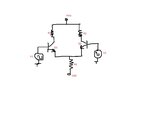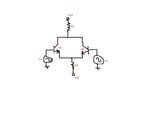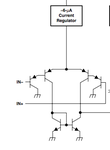Shayaan_Mustafa
Full Member level 5
Hello experts!
I hope all of you will be fine.
Here is image.

As you can see, it is the differential amplifier i.e. the first circuit of the Opamp.
We know for differential amplifier we choose transistors to be identical with all respects. So their emitter are also common and share one resistor RE as shown in figure.
Why don't we do this with collector? We know R1 and R2 should be identical so why don't collector one resistor rather two?
In short, why the circuit should not look like this,

I hope all of you will be fine.
Here is image.

As you can see, it is the differential amplifier i.e. the first circuit of the Opamp.
We know for differential amplifier we choose transistors to be identical with all respects. So their emitter are also common and share one resistor RE as shown in figure.
Why don't we do this with collector? We know R1 and R2 should be identical so why don't collector one resistor rather two?
In short, why the circuit should not look like this,

